May 27, 2025
Suitability Analysis of the CME CF XRP-Dollar Reference Rate as a Basis for Regulated Financial Products
XRP and XRPL: high speeds, low-costs, finite economics
Overview
XRP is the fourth-largest cryptocurrency in terms of market value, with a free-float market capitalization of approximately $143 billion as of mid-May, 2025, based on CF Benchmarks-compiled free-floating supply and transaction data.
XRP is the native token of the XRP Ledger (XRPL), an open-source, decentralized, layer-1 blockchain, known for cost-effective payments and fast transaction speeds.
These features have made XRPL popular with major financial institutions, such as banks, fintechs and cryptocurrency exchanges, which deploy it for real-time cross-border payments, remittances and tokenization projects, among other uses.
More than $1 trillion in value has been transacted over the network since it was established by the founders of Ripple Labs, Inc., in 2012.
An alternative consensus mechanism
XRPL stands out in the digital asset space because its consensus protocol is neither Proof-of-Work (PoW) based (like, for example, Bitcoin's), nor Proof-of-Stake (PoS) based (such as Ethereum's). Neither is its network consensus achieved by some variation of these two best-known consensus methodologies. How then does the ledger achieve transaction finality, and seek to guarantee network integrity and security, all critical pillars of the ultimate value of XRP?
In fact, XRPL utilizes its own unique mechanism called the XRP Ledger Consensus Protocol, based on what is known as the Ripple Consensus Protocol Algorithm (RCPA). RCPA determines the rules underlying a selective network of distributed validator nodes. Technically, this arrangement is known as a federated Byzantine agreement model.
Chiefly, the XRPL Consensus Protocol requires each transaction to be verified by at least 80% of nodes. Additionally, while eligibility to become a validator is open to all, Ripple applies an additional layer of verification by use of a trusted list of nodes called the Unique Node List.
All told, the XRPL Consensus Protocol is in many ways a more streamlined model than PoW or PoS consensus mechanisms, facilitating faster finalization, whilst still maintaining network security.
Economic model
Another critical consideration for the value of XRPL, and ultimately XRP, is the network's economic model. In keeping with its non-mining mechanism, all XRP tokens were 'pre-mined' when the network was established; in other words the total supply was minted at genesis. There are 100 billion XRP in existence1. Ripple maintains control of 80%. Of that portion, 55 billion are kept in escrow, with a small fraction of tokens released each month. This finite model, with predictable increases in circulating supply, maintains the XRPL economy in a relatively balanced state, which, alongside the network's utility, helps underpin the value of XRP.
Benchmarking the Price of XRP
The likelihood that institutional participation in XRP will continue to increase underscores the need for price benchmarks that are demonstrably fit for the purpose of pricing this growing asset. Whilst XRP is a relatively novel cryptoasset, the characteristics and standards required of it by institutions are no different from those required of a benchmark price for any other asset.
For a pricing source to be utilized by regulated institutions as the benchmark for regulated products, it must fulfill what CF Benchmarks has referred to as the 'Three Rs', three essential prerequisites that determine its suitability for this role. These pillars also determine whether or not a price source meets the standards required of pricing benchmarks as defined by the Benchmarks Regulation (BMR) framework2: the benchmark must be representative of the underlying market, resistant to manipulation, and replicable by market participants.
The CME CF XRP-Dollar Reference Rate (XRPUSD_RR)
This paper seeks to understand whether these qualities are achieved by CF Benchmarks' CME CF XRP-Dollar Reference Rate (XRPUSD_RR). The CME CF XRP-Dollar Reference Rate is a once-a-day benchmark index price for XRP denominated in U.S. dollars. Input data are obtained from major cryptocurrency exchanges that conform to the CME CF Constituent Exchange Criteria. Calculated every day since its launch on October 1st, 2017, XRPUSD_RR is a regulated Benchmark under the UK Benchmarks Regulation (BMR) framework.
Calculation Methodology
The XRPUSD_RR calculation methodology aggregates transactions of XRP in U.S. dollars conducted only on the most liquid markets for which data are publicly available, and which are operated by exchanges that meet the CME CF Constituent Exchange Criteria.
The list of Constituent Exchanges and information about changes to its composition are available at the following URL:
https://docs.cfbenchmarks.com/CME%20CF%20Constituent%20Exchanges%20Criteria.pdf
The full methodology is also available here:
https://docs.cfbenchmarks.com/CME%20CF%20Reference%20Rates%20Methodology.pdf
The methodology can be summarised thus:
- Transactions conducted on Constituent Exchanges are observed during a one-hour window from 15:00 to 16:00 London Time
- The one-hour window is divided into 12 partitions of equal length (five minutes each)
- For each partition, a volume-weighted median (VWM) is calculated
- The index value is expressed as the arithmetic mean of the 12 VWMs calculated in the previous step
Suitability of 16:00 London Time for calculation
The graph in Figure 1 illustrates the rationale for calculating the CME CF XRP-Dollar Reference Rate at 16:00 London Time. For the data set illustrated, XRP-U.S. dollar transaction volumes on Constituent Exchanges were measured over an observation period of April 1st, 2023, to April 30th, 2025.
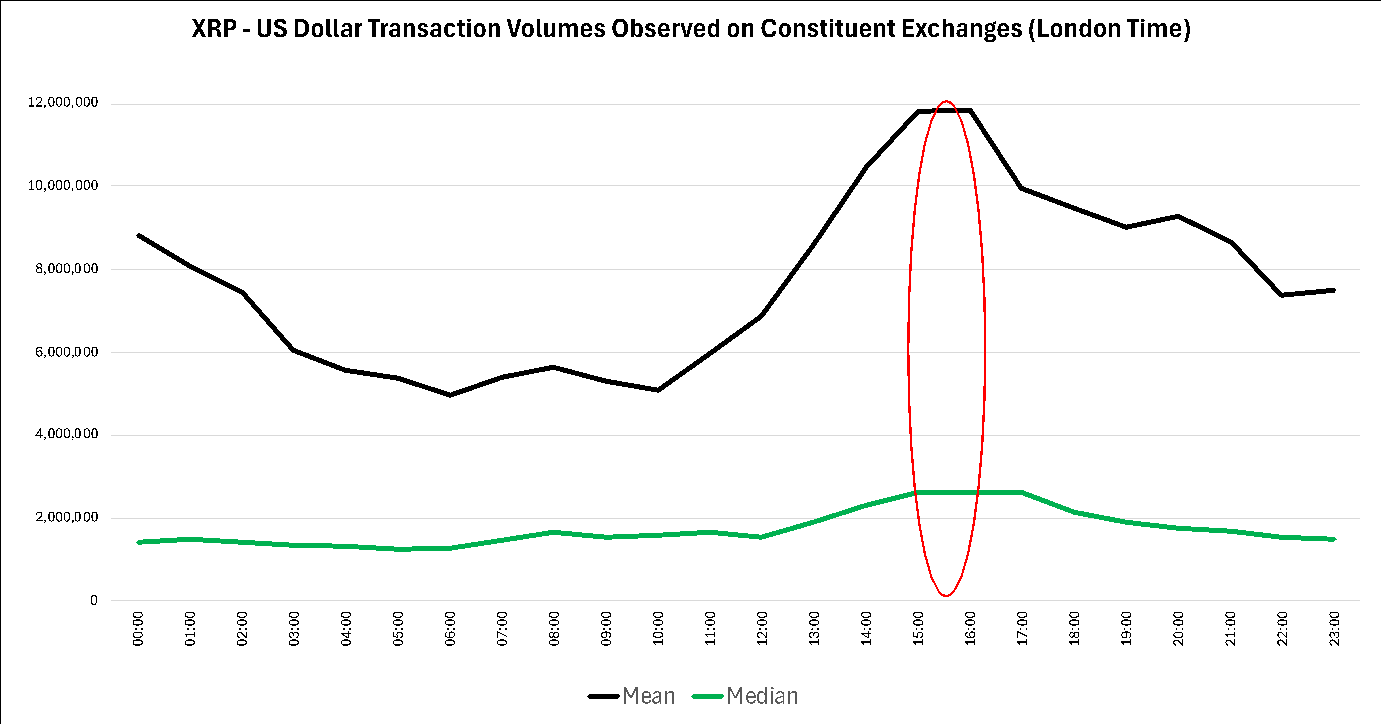
Unlike most traditional assets, XRP can be traded at any time of the day. But the trading data illustrated in the chart above clearly indicates that daily XRP trading volumes tend to be at their highest when traditional markets experience peak trading volumes of their own.
With the most liquid time of the day for XRP Constituent Exchange volumes occurring between 15:00 and 16:00 London Time, together with the traditional market close of several large European markets also being 16:00 London Time, 15:00 to 16:00 London Time appears to be the best possible one-hour window for measuring transactions of a daily benchmark XRP price.
Benchmark validity and volume sufficiency
A valid and robust benchmark needs to be calculated from input data of sufficient volume so that it is representative of the market it seeks to measure. From a practical perspective, volume sufficiency is also key in order for the benchmark to be replicated by institutional market participants, and product providers who need to warehouse price risk. To gauge how well XRPUSD_RR meets the volume sufficiency requirement, the average XRP volume per day and average U.S. dollar value per day contributed to the index calculation each month over the observation period are presented in Figure 2.
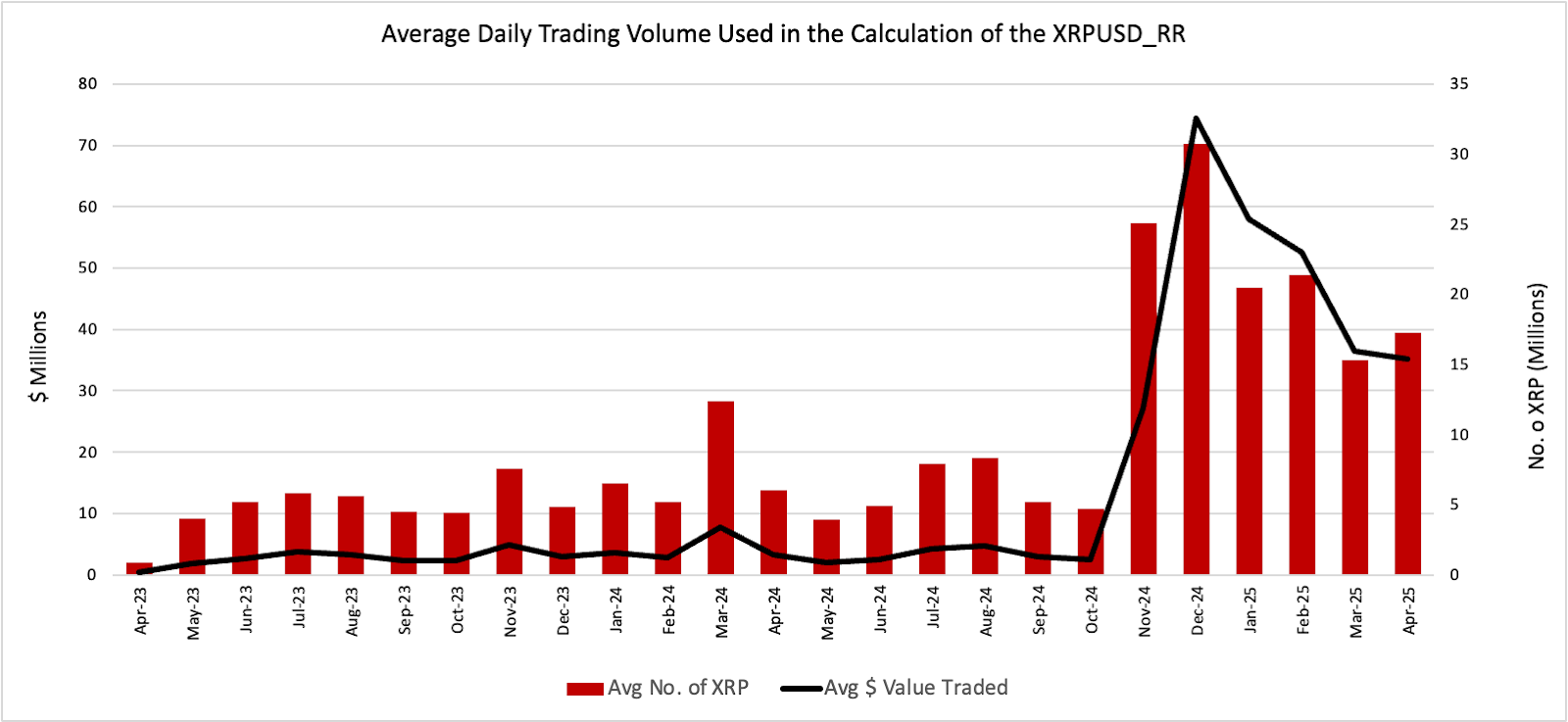
Between April 1st, 2023, to April 30th 2025, on average, 9,537,887 XRP, or $22.55M (at contemporaneous U.S. dollar prices) were traded across an average of 11,727 transactions during each daily observation window between 15:00 and 16:00 London Time on the XRP-USD markets of CME CF Constituent Exchanges used as input data to the XRPUSD_RR. Whilst trading activity exhibits volatility, this volatility is not substantially different from that shown in traditional asset markets. In conclusion, the volume observed and the reliability of that volume are clearly evident to be sufficient for the calculation of a robust and reliable benchmark.
Resistance to Manipulation – Benchmark Integrity
This section will address the question of whether the CME CF XRP-Dollar Reference Rate is possessed of integrity in the specific sense applied by securities regulations. The practical imperative is that a benchmark requires integrity because it will be used for a wide range of activities such as asset valuation, settlement of financial risk, risk management, NAV calculation, unit creation and unit redemption. Specifically, the benchmark must both be shown to be free of manipulation and furthermore, it must be administered and calculated in a manner that deters and impedes manipulation.
Deterring and Impeding Manipulation
The methodological design underlying the CME CF XRP-Dollar Reference Rate and its system of administration incorporate measures that promote integrity as outlined in the sub-sections below.
Impeding manipulation by input data selection
CF Benchmarks exclusively sources input data from Constituent Exchanges that meet published criteria as set out in its Constituent Exchanges Criteria. The criteria are available at this link: https://docs.cfbenchmarks.com/CME%20CF%20Constituent%20Exchanges%20Criteria.pdf. Particular attention is drawn to the following statement from the Constituent Exchanges Criteria document (part 2 of Section 3, page 5: ‘Eligibility Criteria’):
“The venue has policies to ensure fair and transparent market conditions at all times and has processes in place to identify and impede illegal, unfair or manipulative trading practices.”
CF Benchmarks ascertains the presence of fair and transparent market conditions and processes to identify and impede illegal, unfair or manipulative practices by conducting a thorough review of any exchange under consideration for inclusion as a Constituent Exchange. The arrangements of all Constituent Exchanges are reviewed annually to ensure they continue to meet all criteria specified within “Constituent Exchange Criteria”. This due diligence is documented, and the information is distributed to CF Benchmarks’ oversight organs to consider. The deliberations of oversight organs are conducted during regular meetings, minutes of such meetings are publicly available, being published by the Administrator on its website.
Manipulation resistance by design
Resistance to manipulation is a priority aim of the design methodology underlying XRPUSD_RR. The methodology takes an observation period and divides it into equal partitions of time. The volume-weighted median of all transactions within each partition is then calculated. The benchmark index value is determined by the arithmetic mean of the volume-weighted medians, equally weighted. The benefits of this process with respect to achieving manipulation resistance are outlined below.
- Use of partitions
Individual trades of large size have limited effect on the index level as they only influence the level of the volume-weighted median for that specific partition.
A cluster of trades in a short period of time will also only influence the volume-weighted median of the partition or partitions they were conducted in.
- Use of volume-weighted medians
Use of volume-weighted medians as opposed to volume-weighted means ensures that transactions conducted at outlying prices do not have an undue effect on the value of a specific partition.
- Equal weighting of partitions
By not volume weighting partitions, trades of large size or clusters of trades over a short period of time will not have an undue influence on the index level.
- Equal weighting of constituent exchanges
CF Benchmarks applies equal weight to transactions observed from CME CF Constituent Exchanges. With no pre-set weights, potential manipulators cannot target one platform for the conduct of manipulative trades.
- Use of arithmetic mean of partitions
Using the arithmetic mean of partitions of equal weight further denudes the effect of trades of large size at prices that deviate from the prevailing price having undue influence on the benchmark level.
Manipulation resistance by exclusion of input data.
A specific procedure for dealing with potentially erroneous data is incorporated into the methodology of XRPUSD_RR. Although volume-weighted medians of transaction prices from individual data sources are not part of the benchmark determination process, they are calculated as a means of quality control and manipulation resistance.
In the event of an instance of index calculation in which a Constituent Exchange’s volume-weighted median transaction price exhibits an absolute percentage deviation from the volume-weighted median price of other Constituent Exchange transactions greater than the potentially erroneous data parameter (10%), then transactions from that Constituent Exchange are deemed potentially erroneous and excluded from the index calculation. All instances of data excluded from a calculation trigger a Benchmark Surveillance Alert that is investigated.
The potentially erroneous data parameter for XRPUSD_RR was not triggered at any time between April 1st, 2022, to April 30th, 2025. Analysis of the max volume-weighted median deviation per exchange during the observation period produced the results in Table 1. The results illustrate that during the observation period, no Constituent Exchange’s input data needed to be excluded due to exhibiting potential manipulation, and indeed no individual cryptocurrency exchange exhibited a deviation percentage above 1.74% during this period.
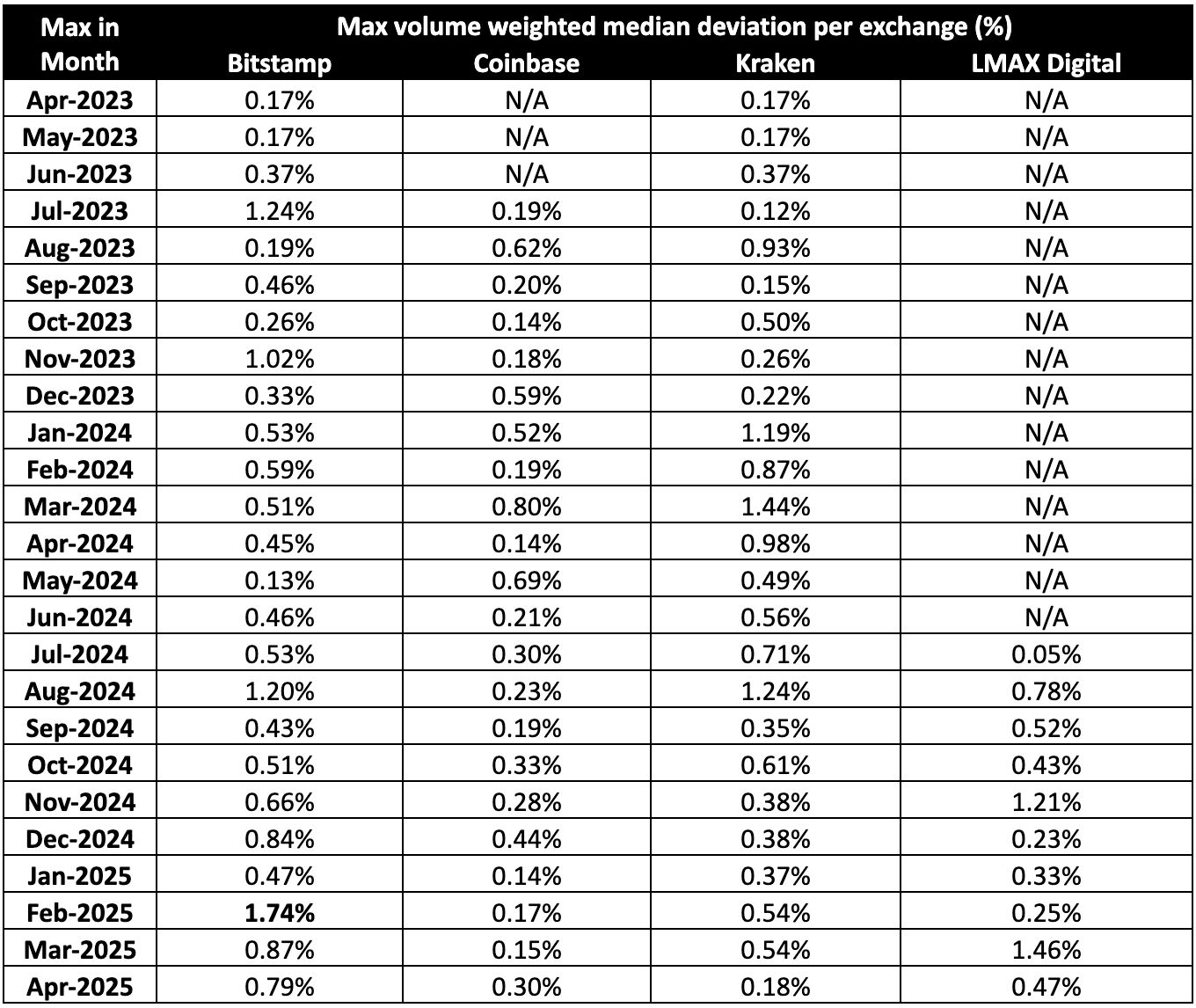
Note: Coinbase was added as a Constituent Exchange from July 2023 and LMAX Digital was added as a Constituent Exchange from July 2024
Benchmark Surveillance
Although a series of measures have been undertaken to mitigate the risk of benchmark manipulation, CF Benchmarks remains vigilant against attempted benchmark manipulation and monitors input data continuously. To that end, CF Benchmarks has implemented a benchmark surveillance program for the investigation of alerts. Instances of suspected benchmark manipulation are escalated through appropriate regulatory channels in accordance with CF Benchmarks’ obligations under the UK Benchmarks Regulation (UK BMR). Regarding benchmark manipulation, Article 14 of the UK BMR, Reporting of Infringements, states:
- An administrator shall establish adequate systems and effective controls to ensure the integrity of input data in order to be able to identify and report to the competent authority any conduct that may involve manipulation or attempted manipulation of a benchmark, under Regulation (EU) No. 596/2014.
- An administrator shall monitor input data and contributors in order to be able to notify the competent authority and provide all relevant information where the administrator suspects that, in relation to a benchmark, any conduct has taken place that may involve manipulation or attempted manipulation of the benchmark, under Regulation (EU) No. 596/2014, including collusion to do so.”
As a regulated Benchmark Administrator, CF Benchmarks is subject to supervision by the UK FCA. Furthermore, CF Benchmarks’ Control Procedures with respect to compliance with the UK BMR have been audited by ‘Big Four’ accountancy firm Deloitte. The Independent Reasonable Assurance Report on Control Procedures Noted by CF Benchmarks Regarding Compliance with the UK Benchmarks Regulation between September 12th, 2022 and September 12th, 2024 is available at the following link: https://www.cfbenchmarks.com/legal/audit.
This further verification of CF Benchmarks’ compliance with the UK BMR places the CME CF XRP-Dollar Reference Rate on the same level of scrutiny applied to widely used traditional financial benchmarks like ICE SWAP, SONIA and RONIA.
Assessing XRPUSD_RR values and input data for signs of manipulation
Whilst XRPUSD_RR was designed and is administered to the highest standards, including efforts to uphold provisions of the UK BMR, the proof of the pudding is in the eating, and further analysis of the data is required.
Were there to be a lack of integrity in the input data that could in turn affect the integrity of the benchmark, one would expect to see one of a number of phenomena reflected in the input data provided by Constituent Exchanges. One potential example would be significant price dislocations between Constituent Exchanges.
How well correlated are Constituent Exchange prices?
An analysis was undertaken of the pairwise correlation of prices from Constituent Exchanges on a per-minute basis (the price difference between transactions for each minute at each exchange) during the observation period. The results of this analysis are shown in Table 2.
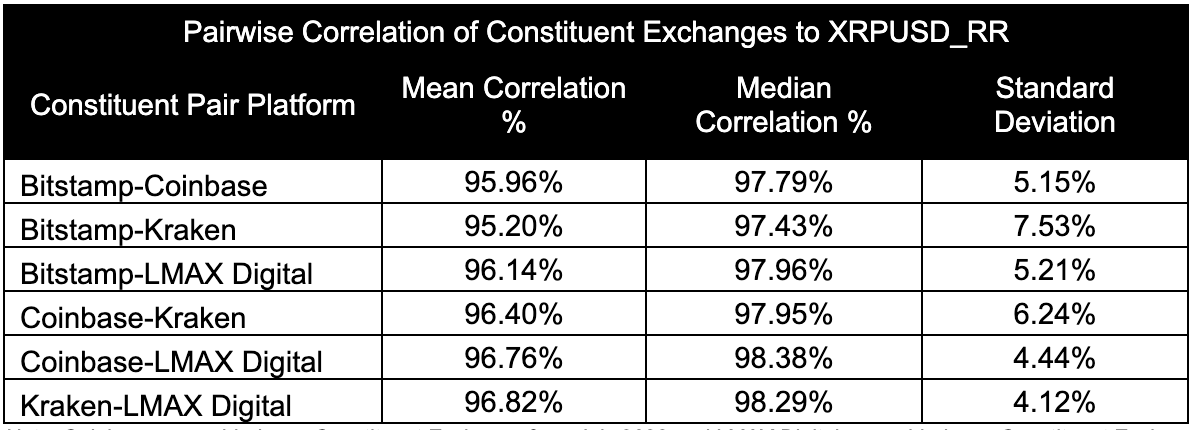
Note: Coinbase was added as a Constituent Exchange from July 2023 and LMAX Digital was added as a Constituent Exchange from July 2024
To illustrate the data analyzed in Table 2 in graphical form, Figure 3 (below) displays the full data set. The clustering towards correlation coefficients of 1.00, and the fact that on less than 0.37% of days did any exchange have a correlation with another exchange below 0.5, demonstrate strong price correlation between the Constituent Exchanges and point towards fair and orderly markets.
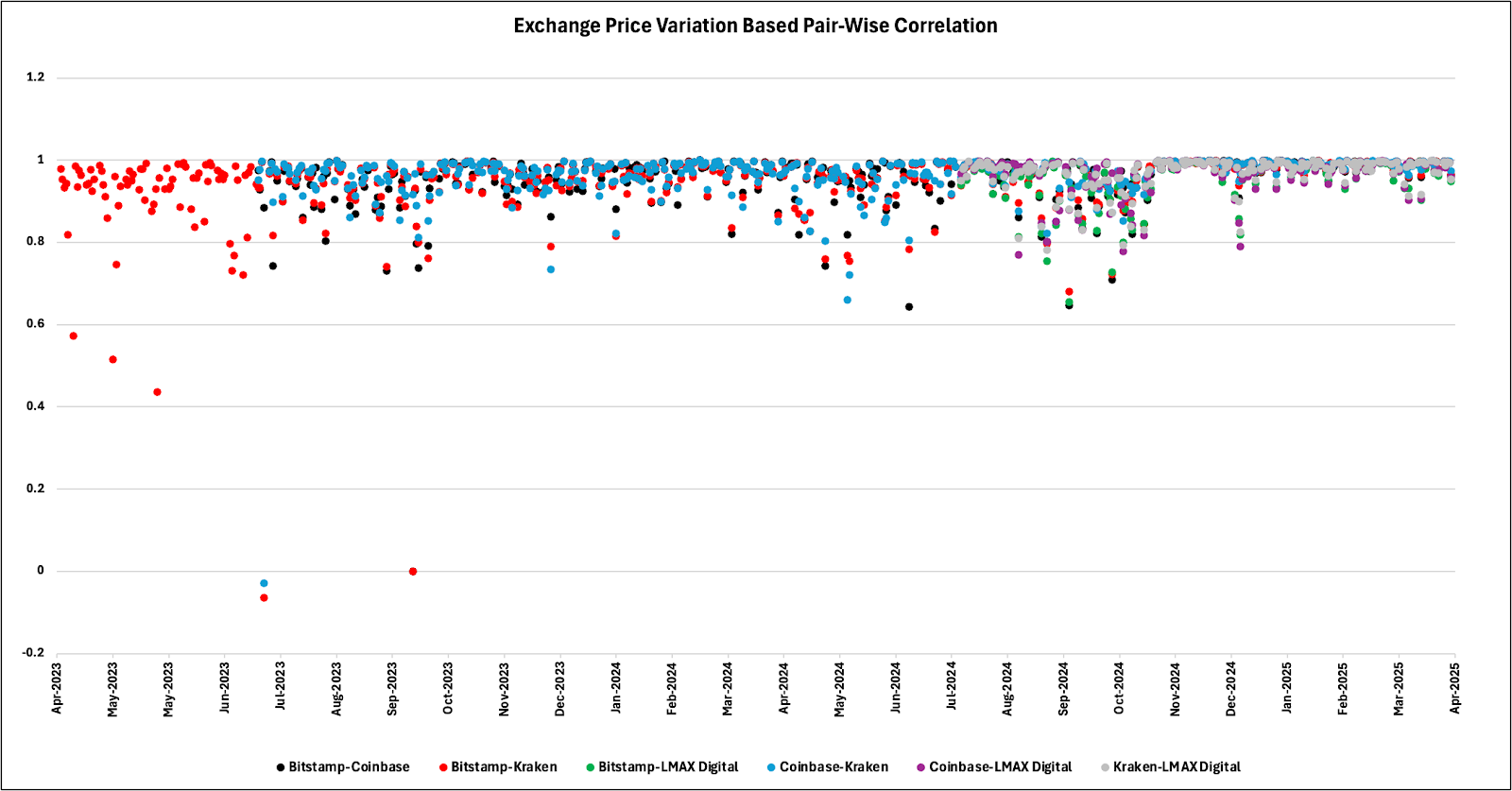
Replicability and Implementation
The final characteristic of XRPUSD_RR that this paper will examine with respect to its merits as a benchmark price is its replicability. In other words, that the XRPUSD_RR benchmark price can be transacted in practice on any given day without undue risk.
Buying and selling large amounts of XRP at XRPUSD_RR
To begin demonstrating the replicability—or to use another term, the achievability—of the strategy presented in this paper for purchasing XRP at scale, observations taken whilst modeling the purchase or sale of a notional large amount of XRP are presented below. It was decided that the purchase or sale of 250,791 XRP (c. $593,000 at prevailing prices) was at an adequate scale to represent a large XRP trade of the kind that institutional traders might need to undertake for a client, or that an issuer of a financial product (such as an ETF or a derivative) would be required to execute on any given day, in order to facilitate trading of that product. A simple replication simulation was conducted to demonstrate the extent of slippage that implementation of XRPUSD_RR would probably encounter. Given that the purpose was to demonstrate institutionally sized liquidity, the simulation was conducted for weekdays only.
Simulation Methodology
- Trades are executed on n (5) Constituent Exchanges, during a 3,600-second window
- One trade is executed every second, and the price achieved is assumed to be the last execution price observed in that second. Its associated volume is assumed to be the volume executed during that second
- If no trade is completed in any single-second period, then the price achieved is assumed to be the price achieved in the previous second, but the associated volume from the previous second is not added to the volume executed in the latest second
It is worth noting that in the ‘real world’, institutions deploy algorithmic systems to execute large-scale asset purchases. It is highly probable that conducting the exercise presented here by means of algorithmic systems would have produced outcomes that are even more favorable. For research purposes, a simplified simulation methodology was favored to demonstrate the replicability properties of XRPUSD_RR.
The results of this exercise are displayed in Figure 4 and summary data provided in Table 3. As can be seen, XRPUSD_RR can be replicated with a high degree of confidence and usually with slippage, in most cases, below 10 basis points. Indeed, even on the most volatile of days slippage was only 275 basis points.
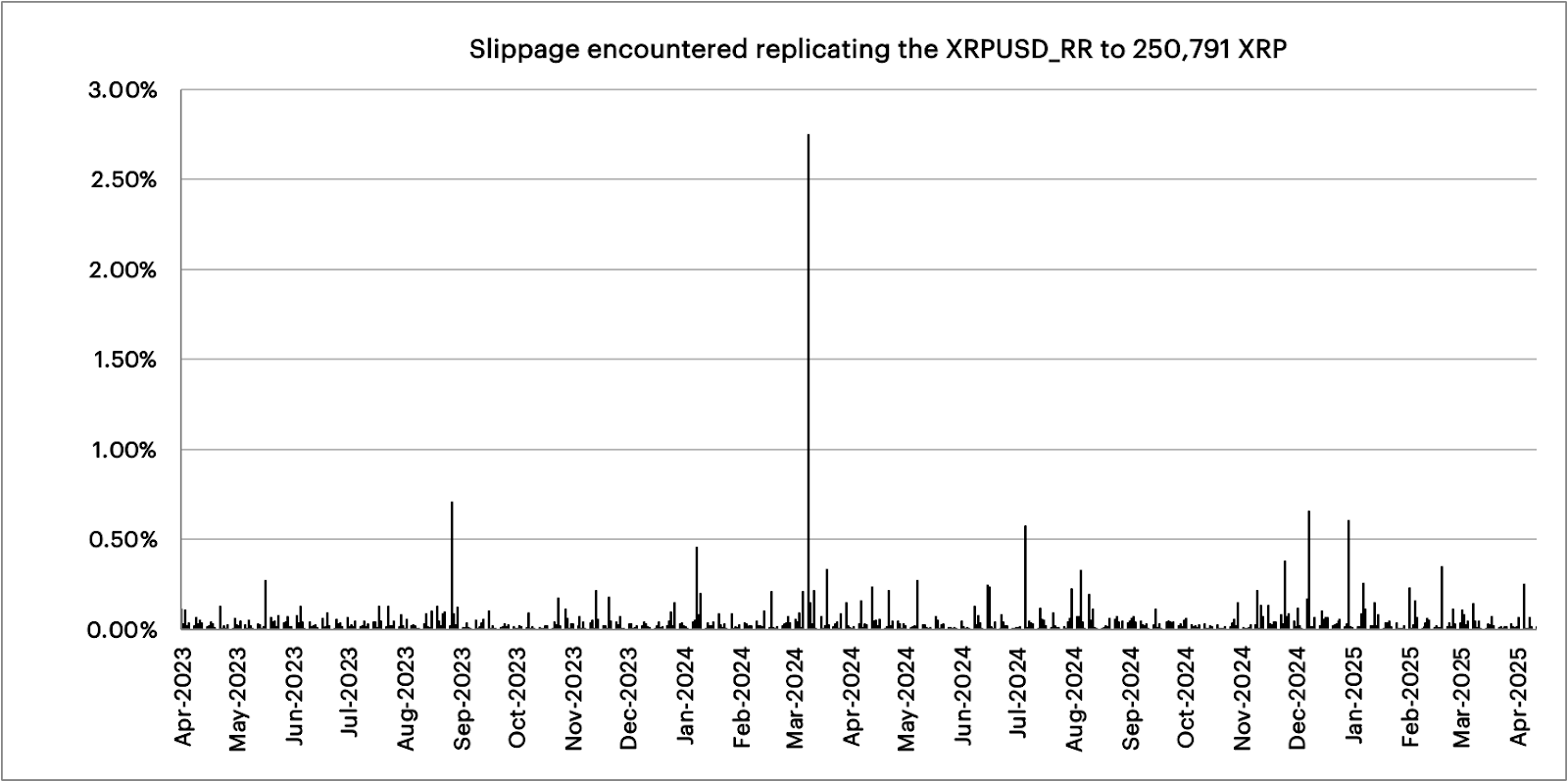
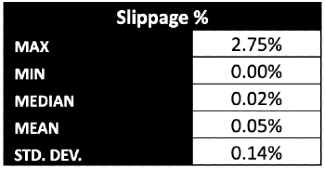
Conclusion
From the analysis conducted it is quite clear that the CME CF XRP-Dollar Reference Rate exhibits all the key properties required of a benchmark.
Representative: XRP-USD markets that are operated by the CME CF Constituent Exchanges during 15:00 to 16:00 London time are liquid, with sufficient volume of trading to represent the market in a robust manner.
Resistant to Manipulation: Its Constituent Exchange Criteria ensures that it takes input data only from cryptocurrency exchanges that exhibit fair and orderly behaviour, where trading data per exchange show strong price correlations with trading data of each of the other exchanges. On top of this, the methodology XRPUSD_RR employs nullifies effects of any manipulation, and the Administrator’s policies and processes regarding surveillance ensure that any manipulation is detected.
Replicable: Its methodology promotes replicability, allowing users to replicate the benchmark simply and without undue risks.
References
- CF Benchmarks. 2025. "XRP: Powering Global Liquidity in Real Time" https://cfbinfo.cfbenchmarks.com/hubfs/XRP%20101/XRP%20Powering%20Global%20Liquidity%20in%20Real%20Time.pdf
- Norton Rose Fulbright. 2020. “Benchmarks: EU and UK regulatory outlook” https://www.nortonrosefulbright.com/en/knowledge/publications/75cdafb6/benchmarks-eu-and-uk-regulatory-outlook
The information contained within is for educational and informational purposes ONLY. It is not intended nor should it be considered an invitation or inducement to buy or sell any of the underlying instruments cited including but not limited to cryptoassets, financial instruments or any instruments that reference any index provided by CF Benchmarks Ltd. This communication is not intended to persuade or incite you to buy or sell security or securities noted within. Any commentary provided is the opinion of the author and should not be considered a personalised recommendation. Please contact your financial adviser or professional before making an investment decision.
Note: Some of the underlying instruments cited within this material may be restricted to certain customer categories in certain jurisdictions.
Sell-Off Intensifies Amid Fed Uncertainty
Our market recap offers a concise overview of key blockchain categories and their recent price action within the broader market context, providing valuable insights for investors and industry practitioners.

Gabriel Selby
Weekly Index Highlights, December 1, 2025
Large caps rebounded in a beta-led rally as Sectors like DeFi and Culture mean reverted. Staking rate changes wavered. Bitcoin implied volatility fell despite realized vol's rise; funding rates diverged: BTC (BIRC) steeper, USDT softer. In Factors: Downside Beta and Liquidity edged Growth and Value.

CF Benchmarks
CF Benchmarks Newsletter Issue 96
The checklist for a durable low—lower implied volatility, term structure back to contango, skew nearer neutral—has been partially met, but not conclusively so, as yet.

Ken Odeluga